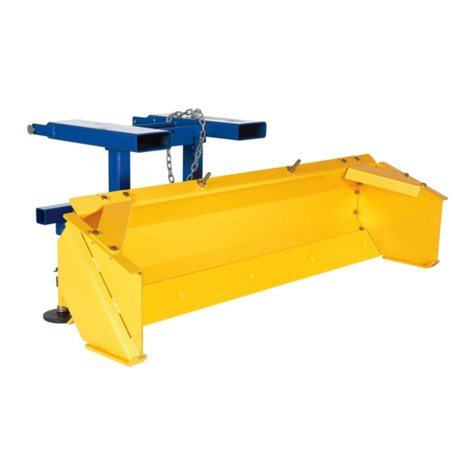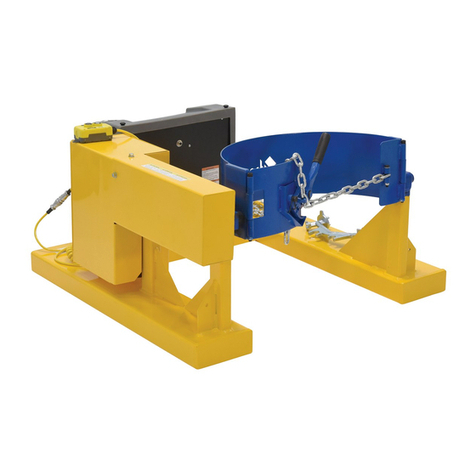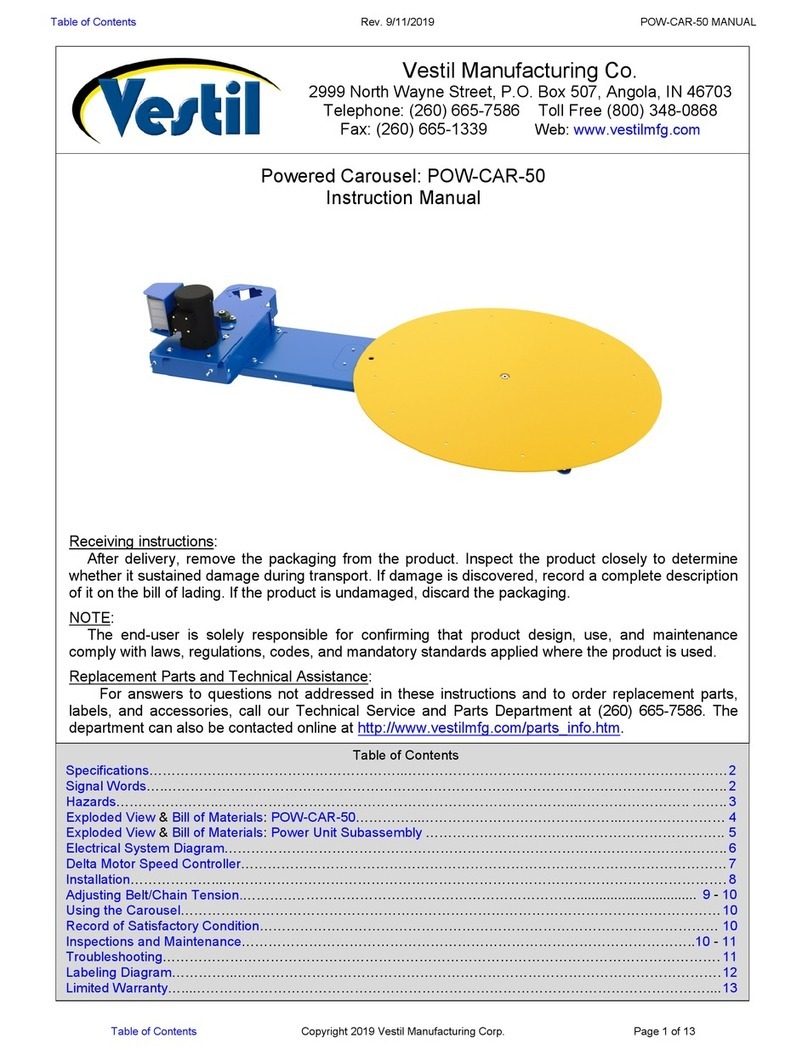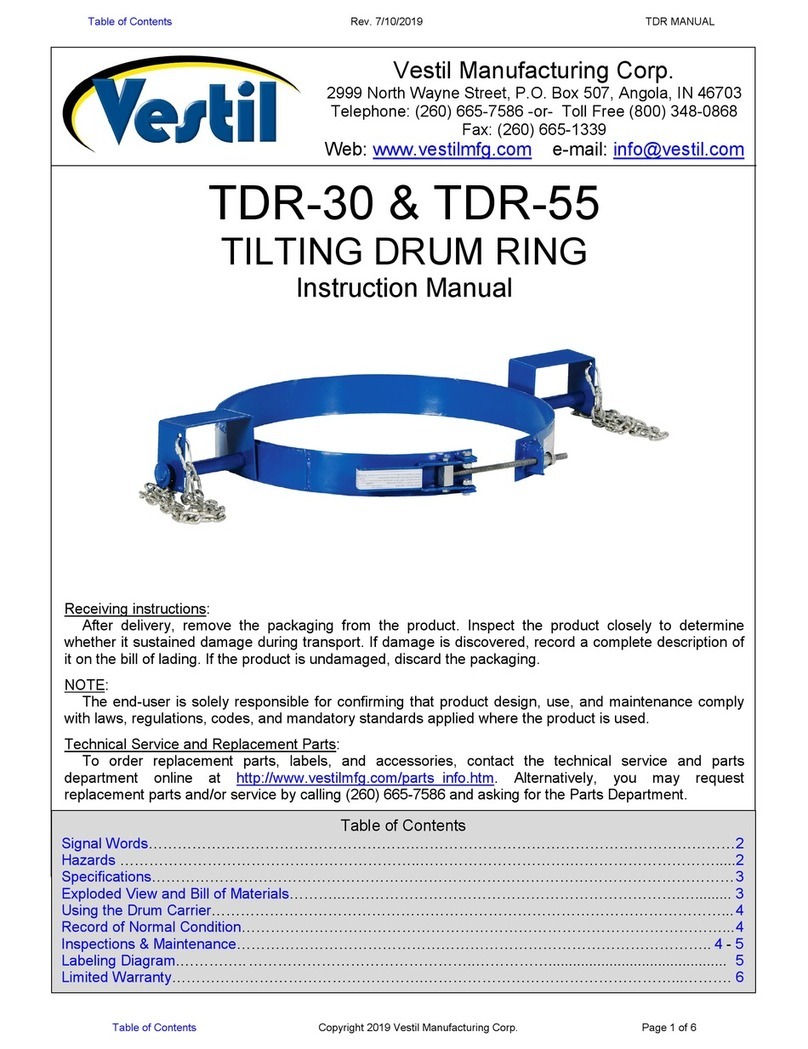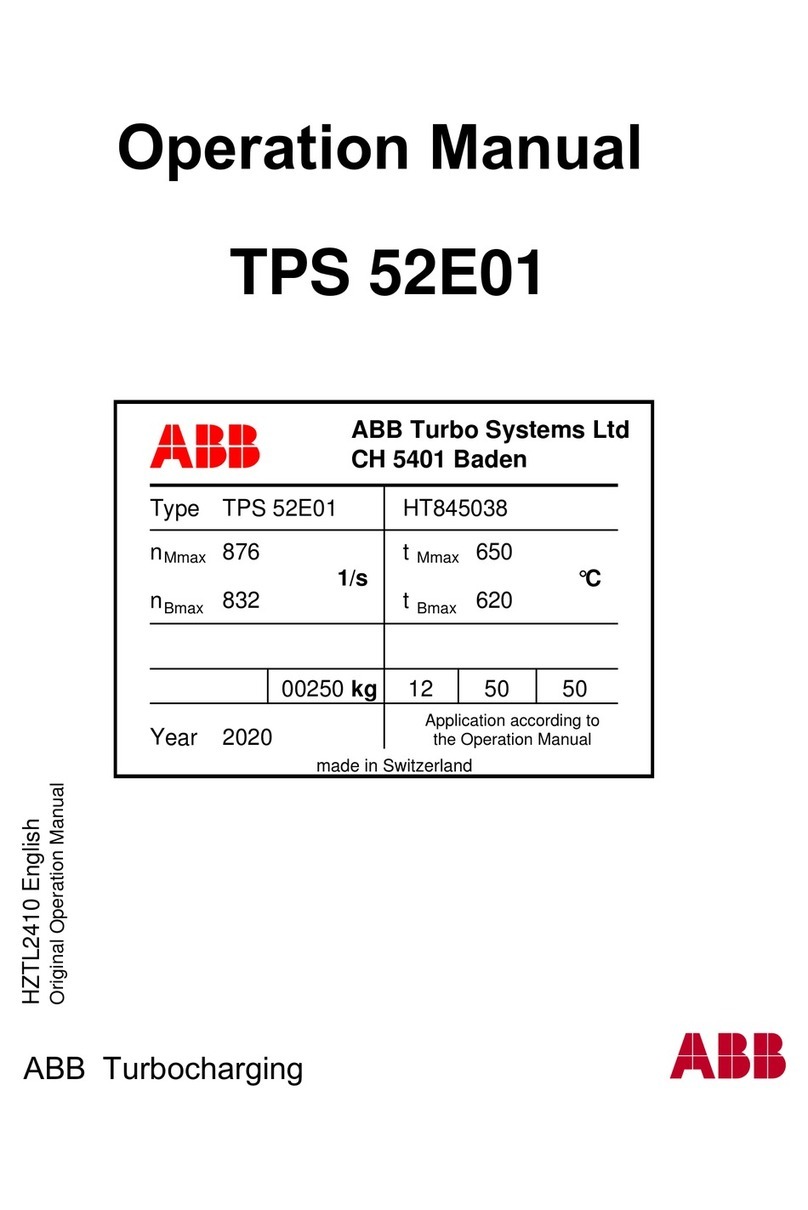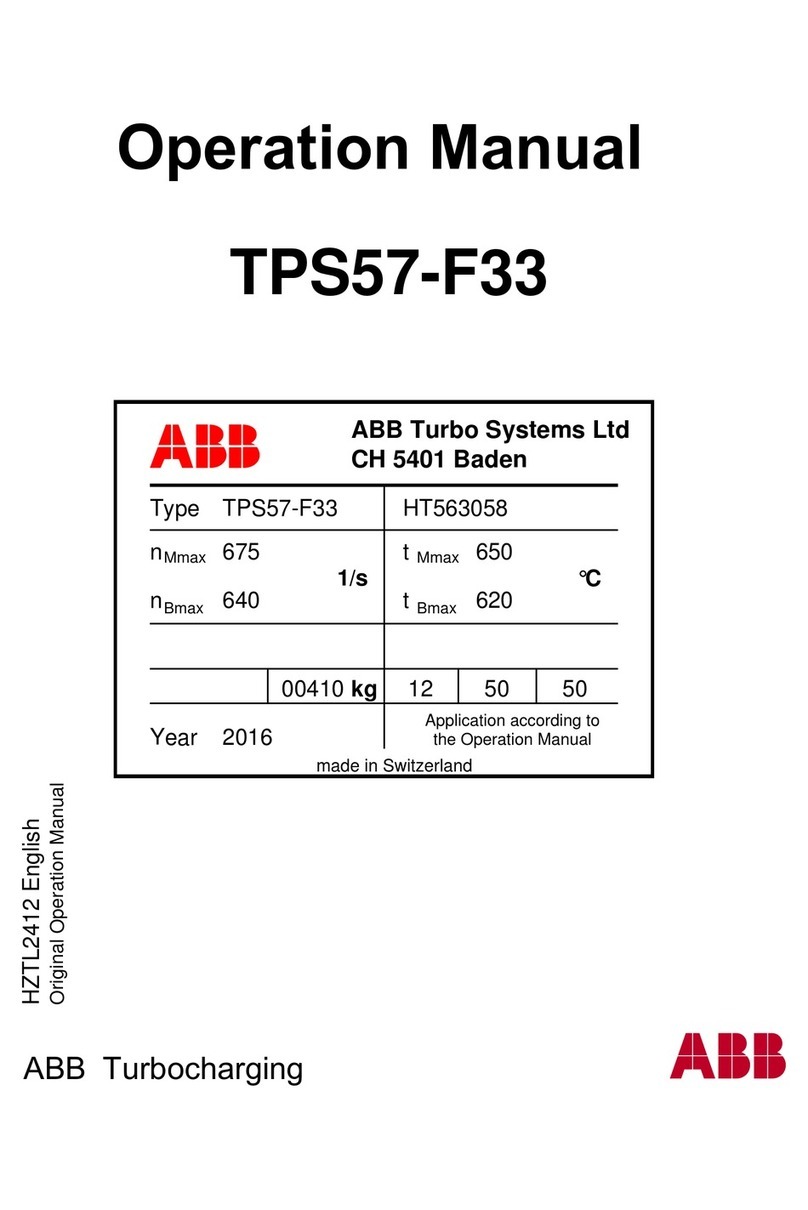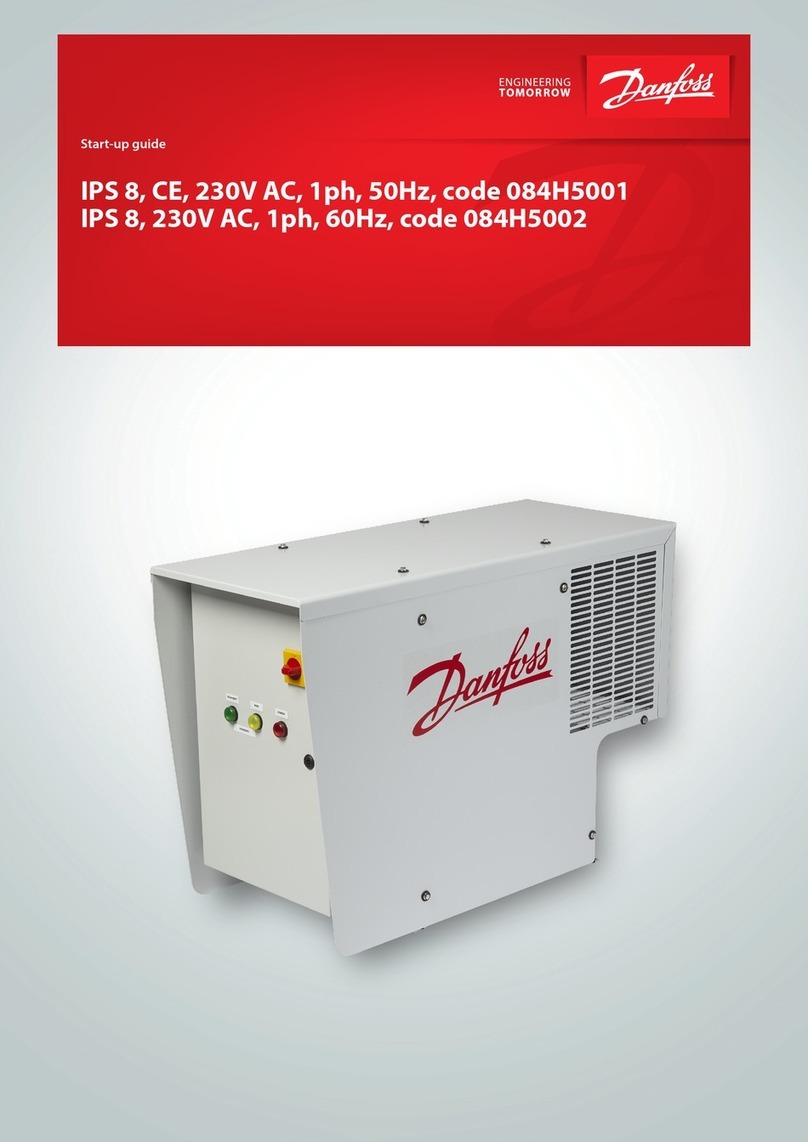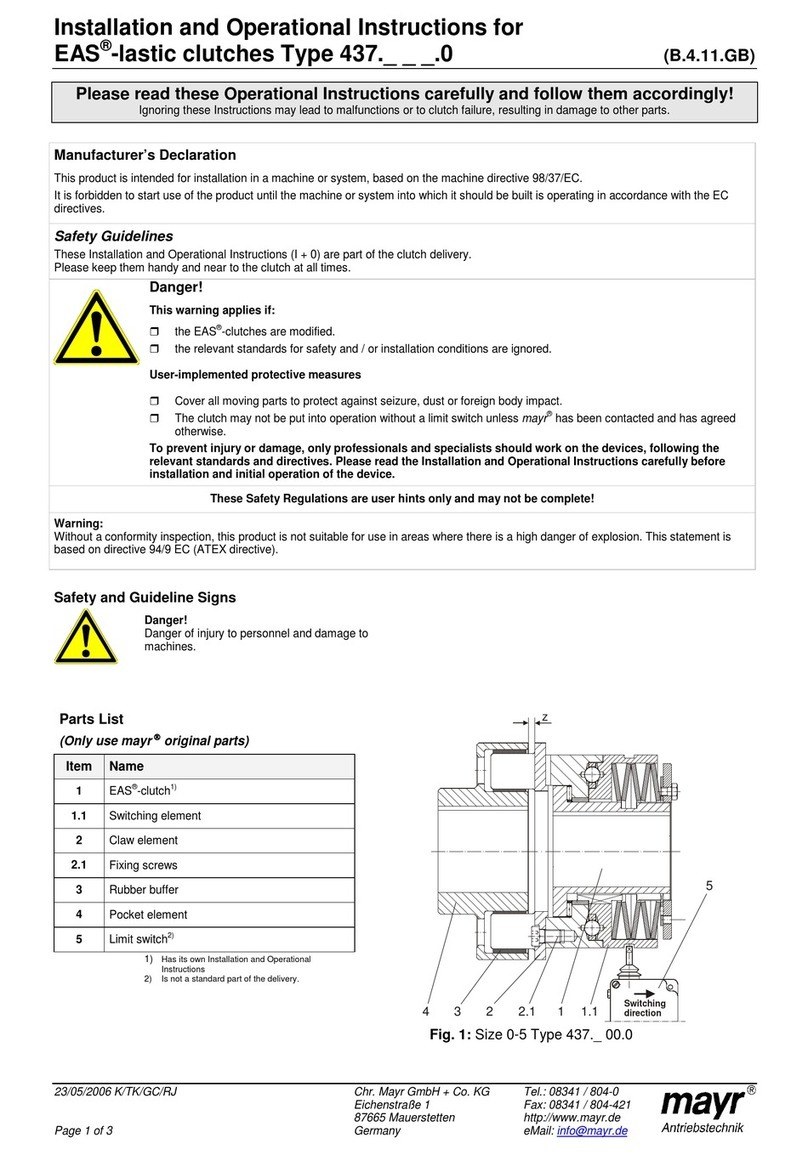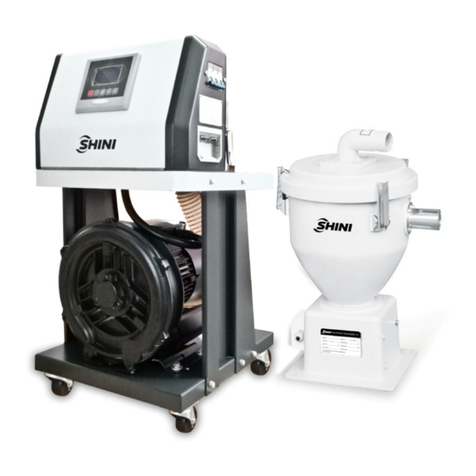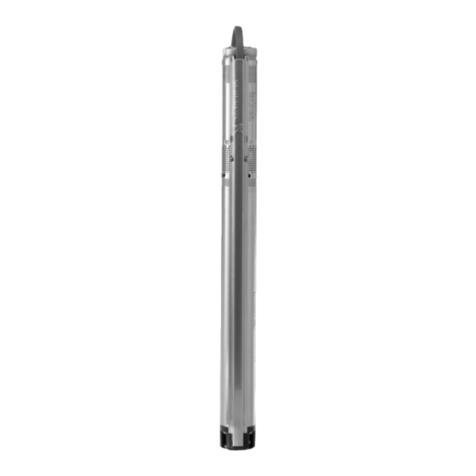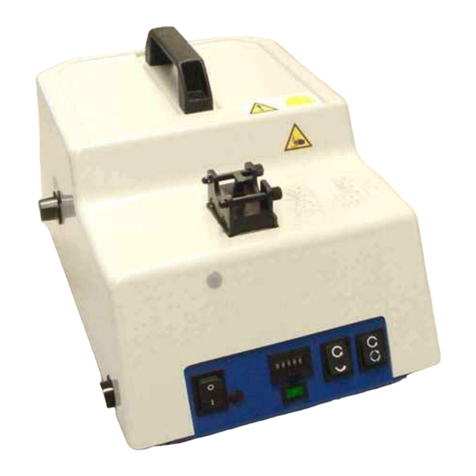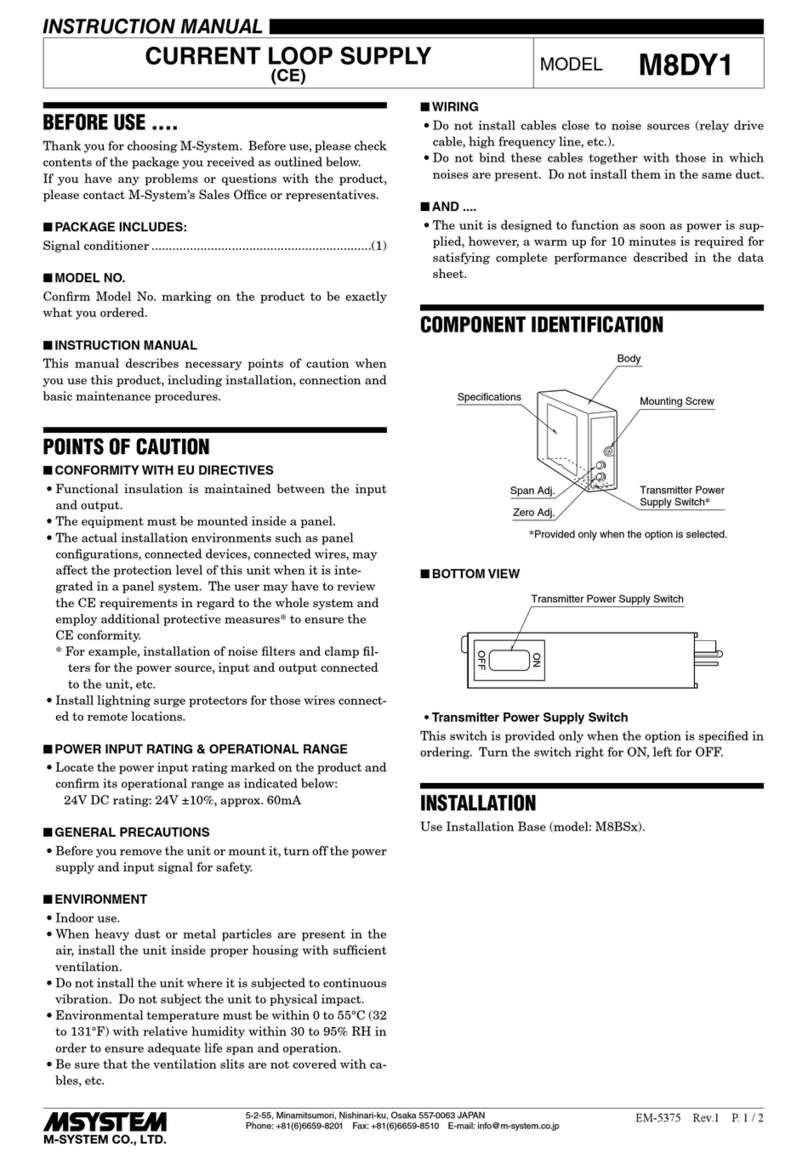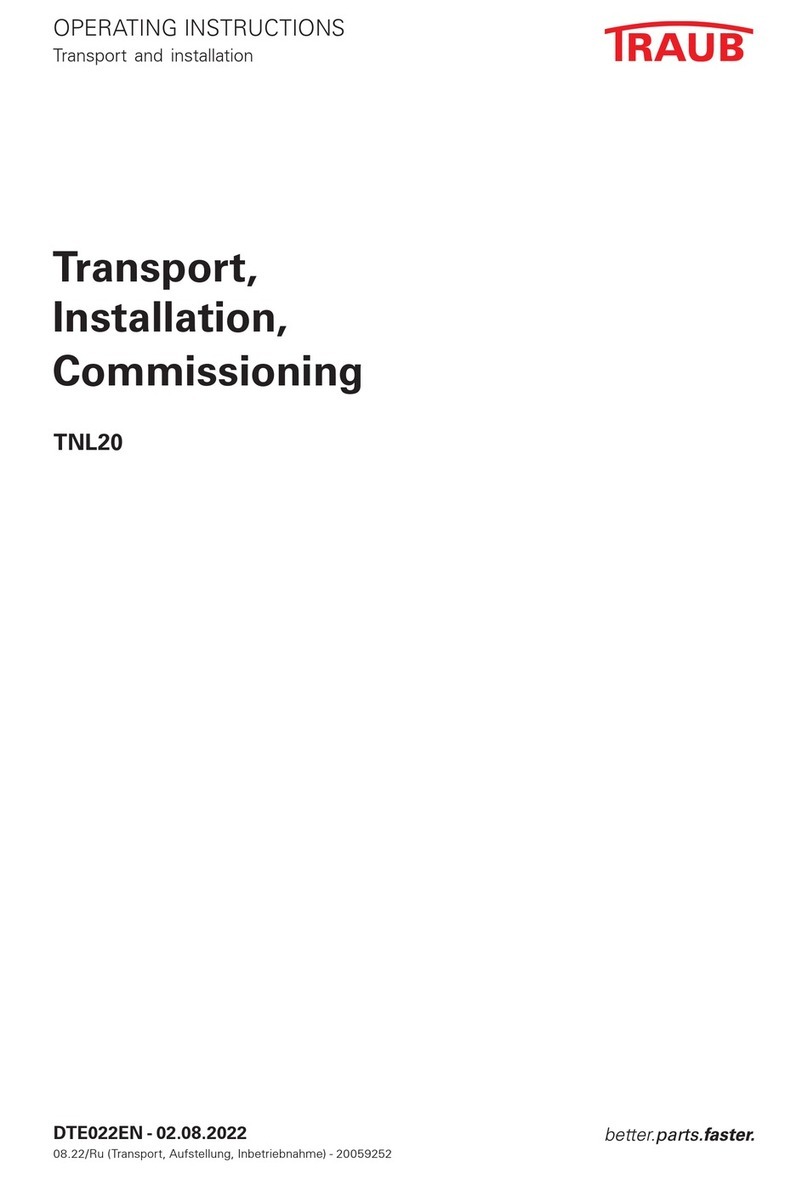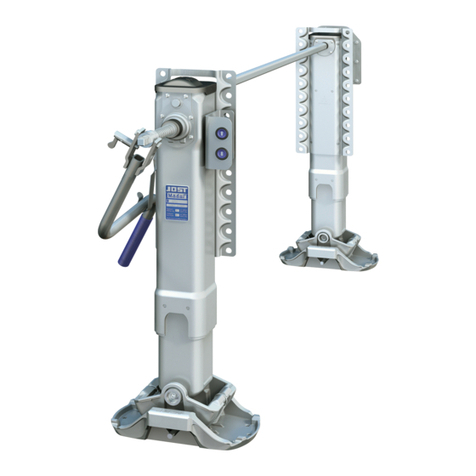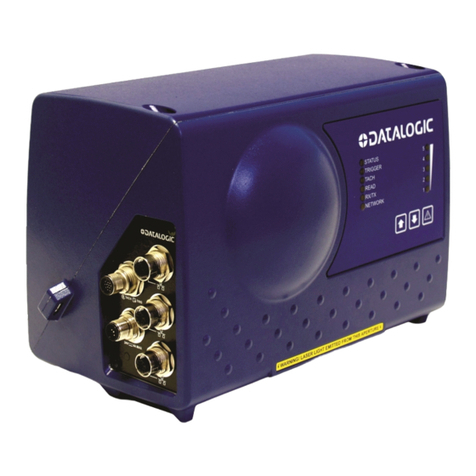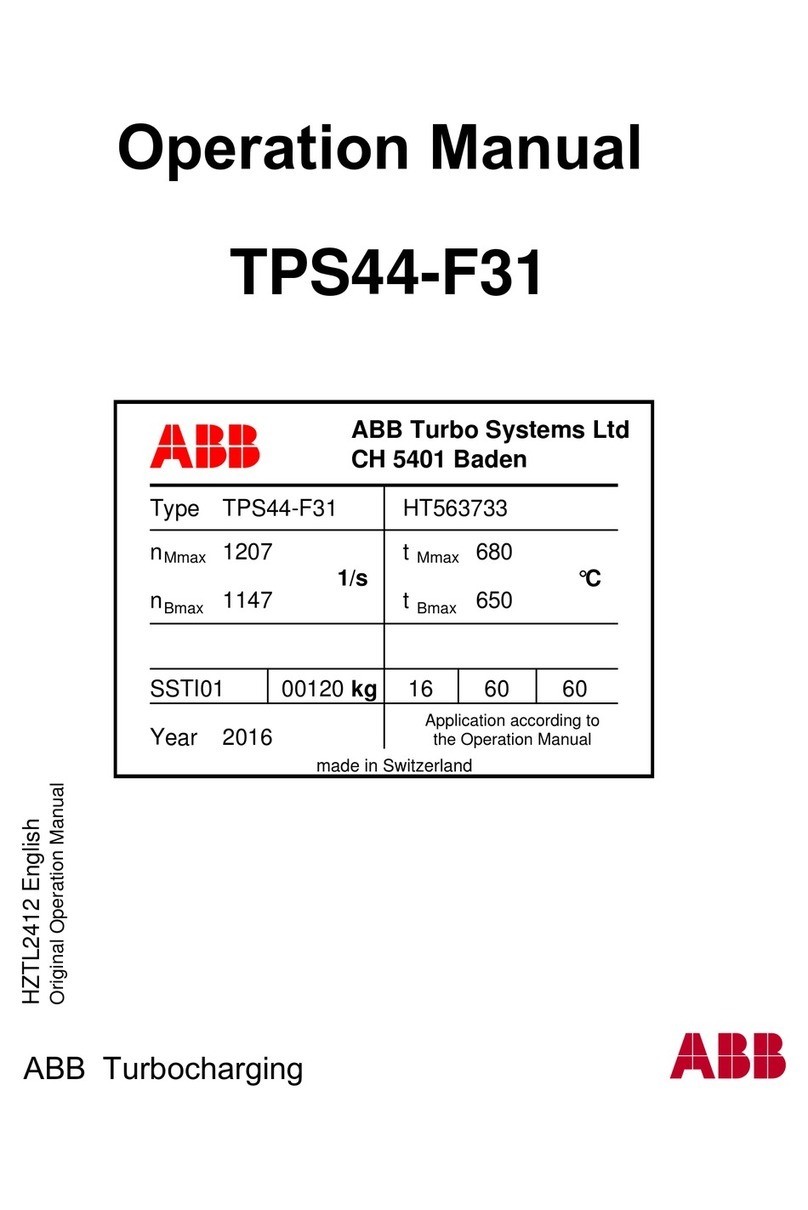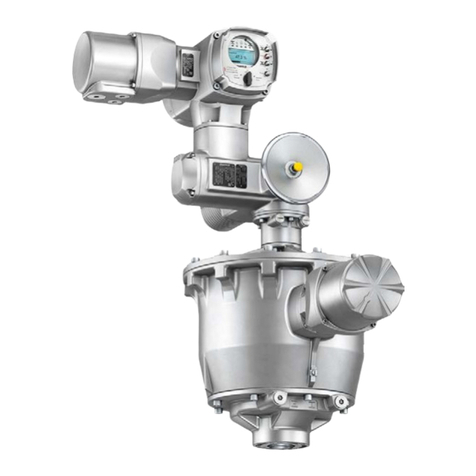Vestil CBB-3000-37 User manual

TABLE OF CONTENTS Rev. 1/17/2023 CBB-3000-37 MANUAL
TABLE OF CONTENTS Copyright 2022 Vestil Manufacturing Co. Page 1 of 19
CBB-3000-37 CARDBOARD BALER
Receiving Instructions
After delivery, remove the packaging from the product. Inspect the product closely to determine
whether it sustained damage during transport. If damage is discovered, record a complete description of it
on the bill of lading. If the product is undamaged, discard the packaging.
NOTE: The end-user is solely responsible for confirming that product design, use, and maintenance comply
with laws, regulations, codes, and mandatory standards applied where the product is used.
Technical Service & Replacement Parts
For answers to questions not addressed in these instructions and to order replacement parts, labels, and
accessories, call our Technical Service and Parts Department at (260) 665-7586. The department can also
be contacted online at https://www.vestil.com/page-parts-request.php.
Electronic Copies of Instruction Manuals
Additional copies of this instruction manual may be downloaded from https://www.vestil.com/page-
manuals.php.
Vestil Manufacturing Co.
2999 North Wayne Street, P.O. Box 507, Angola, IN 46703
Telephone: (260) 665-7586 -or-Toll Free (800) 348-0868
Fax: (260) 665-1339
TABLE OF CONTENTS
PAGE
Signal Words……………………………………………..………………………………………………..………....…..
2
Safety Instructions….…………..……………………………………………..……………………….....……..………
2
Specifications…………………………………………………………………………………………………………….
3
National Standards……………………………………………………………………………………………………...
3
Installing the Baler……………………………………………………………………………………………………….
4
Assembling the Baler……………………………………………………………………………………………………
5- 6
CBB-3000-37 Exploded View & Bill of Materials……….....…………………………..…………..…………….….
7, 8
Power Unit Exploded View & Bill of Materials………...……………….…………..…………………………….…
9
Power Unit Subassembly Exploded View & Bill of Materials……………………………………………………..
10
Motor/Pump Exploded View & Bill of Materials………………………………….………………………………..
10
Manifold Subassembly Exploded View & Bill of Materials..……………….………………………………..…...
11
Hydraulic Circuit Diagram……………………………………………………………………………………………..
11
Manifold, Pressure Switches, and Valves……………….……………………..………………….…………….…..
12
208-230V AC Standard Single Phase Electrical Circuit Diagram……………………………………………….
13
208-230/460V AC Standard 3-Phase Electrical Circuit Diagram……………………………………………….
14
Using the Baler…….…………………………………………………………………………………………………......
15 - 16
Record of Satisfactory Condition……………………………………………………………………………….……
16 - 17
Inspections & Maintenance………..………………………………………………………………………………….
17
Labeling Diagram…………….....…………………………………………………..…………………………….……
18
Limited Warranty…………………………………………………………………...……………..………………….....
19

TABLE OF CONTENTS Rev. 1/17/2023 CBB-3000-37 MANUAL
TABLE OF CONTENTS Copyright 2022 Vestil Manufacturing Co. Page 2 of 19
SIGNAL WORDS
SIGNAL WORDS appear in this manual to draw the reader’s attention to important safety-related
messages. The following are signal words used in this manual and their definitions.
SAFETY INSTRUCTIONS
Vestil strives to identify foreseeable hazards associated with the use of its products, but no manual can
address every conceivable risk. Minimize the likelihood of injury by observing the hazards identified
below and by inspecting and maintaining the product as instructed in INSPECTIONS & MAINTENANCE on
p. 17.
WARNING
Risks of serious personal injuries or death.
Read and understand the entire manual before assembling, using, inspecting, or servicing the baler.
Read and understand the entire manual before installing, using, or servicing the product.
Read the manual whenever necessary to refresh your understanding of proper use and maintenance
procedures.
Do not climb on or into the baler.
Do not operate the machine if the emergency stop switch does not function properly.
Do not stand in front of the door during operation.
Do not disable any of the safety features, e.g. switches, gates/barriers. In particular, the baler must not
be able to operate with the loading door open.
Do not overload the baling chamber.
Keep clear of all moving parts during operation.
High pressure oil easily punctures skin and can cause injury such as gangrene. If a hose or coupling
develops a leak, repair the leak before operating the baler.
Do not continue to use the baler if it is damaged or makes unusual noises during operation.
Do not change the relief valve setting! In particular, do not increase the setting.
Do not clean out baling chamber unless the baler is disconnected from electrical power.
Do not attempt to compact filled boxes with this machine. Only fill the baling chamber with empty
boxes. Evenly distribute cardboard within the chamber to prevent side loading the baler platen.
Do not use brake fluids or jack oils in the hydraulic system. Only use AW-32 hydraulic oil or equivalent
oil.
Do not modify the product in any way. Modifications might make the baler unsafe to use and
automatically void the LIMITED WARRANTY on p. 19.
DO NOT use this device unless every label is in place and easily readable. See LABELING DIAGRAM on.
p. 18. Contact the TECHNICAL SERVICE AND PARTS DEPARTMENT to order replacement labels.
DANGER
Identifies a hazardous situation which, if not avoided, WILL result in DEATH or
SERIOUS INJURY. Use of this signal word is limited to the most extreme
situations.
WARNING
Identifies a hazardous situation which, if not avoided, COULD result in DEATH or
SERIOUS INJURY.
CAUTION
Indicates a hazardous situation which, if not avoided, COULD result in MINOR or
MODERATE injury.
NOTICE
Identifies practices likely to result in product/property damage, such as
operation that might damage the product.
!
!
!
!

TABLE OF CONTENTS Rev. 1/17/2023 CBB-3000-37 MANUAL
TABLE OF CONTENTS Copyright 2022 Vestil Manufacturing Co. Page 3 of 19
SPECIFICATIONS
The CBB-3000-37 is a single-stage, vertical downstroke baler, i.e. single-stage baler in which the ram
only travels up-and-down: A downward compression stroke and an upwards retraction stroke. A
specifications document for CBB-3000-37 balers is available online to anyone who visits Vestil’s
website. Specifications include dimensions, net weight, and capacity information. To access the
appropriate specifications document, navigate to this webpage:
https://www.vestil.com/product.php?FID=1704. Scroll the page to the “Product Specifications Table”.
Click the button in the “PDFs” column that looks like a pencil inside a box. A PDF file will open. This file is
the specifications document. Print a copy of the document and keep it with your copy of this manual.
The following is an exemplar specifications document.
NOTE: If your model is not included on the webpage, or if you cannot access and/or print the
document, contact the TECHNICAL SERVICE DEPT. Contact information is provided on the front page
of this manual.
NATIONAL STANDARDS
American National Standard ANSI Z245.5 “Baling Equipment – Safety Requirements for Installation,
Maintenance and Operation” (the “Standard”) provides inspection, testing, maintenance, and
operation instructions for single-stage, vertical down-stroke balers. The Standard can be purchased
online at https://webstore.ansi.org/Standards/EIA/ANSIZ2452013-1506110. Acquire a copy of the
Standard. Apply all mandatory provisions. Contact local occupational safety and health specialists to
determine whether there are laws, ordinances, codes, etc. (“Authorities”) in addition to the Standard
that apply to balers in the location where it is used. If content in this manual conflicts with provisions in
Authorities or the Standard, apply the provisions from the authorities or Standard. Vestil requests that you
immediately contact TECHNICAL SERVICE to report conflicts.
Unit ships knocked down
(partially disassembled).

TABLE OF CONTENTS Rev. 1/17/2023 CBB-3000-37 MANUAL
TABLE OF CONTENTS Copyright 2022 Vestil Manufacturing Co. Page 4 of 19
INSTALLING THE BALER
The following items are necessary to install the device:
Fork truck.
Lag bolts, masonry drill, masonry bit, and wrench for lag bolt, grout, and steel shims.
Power circuit with voltage matching the voltage of the unit including fuses and disconnect or circuit
breakers. Minimize voltage drop by using adequate wire size. Refer to NEC 70 for power circuit
specifications.
Only install this baler indoors in a location where it will remain dry at all times. Proper installation
requires at least 13ft (W) x 10ft (D) of free floor space and 14ft (H) of unobstructed overhead clearance
(4m x 3.1m of free floor space and 4.3m of overhead clearance).
Insert the forks of your lift truck into the fork tubes and transport the baler to the installation location.
The back side of the baler should be no closer than 24” (61cm) from the closest permanent structure.
The baler should only be installed on a steel reinforced concrete surface of at least 3,000psi capacity.
Concrete must be at least 4 inches (10.2cm) thick.
Mark the floor with the locations of the anchor bolt holes in the 4 mounting brackets (1 at each
corner; arrows in diagrams). Bolt holes will accept 9/16” anchor bolts. 9/16” (14.3mm) anchor bolts
should be 6” long (15.2cm). Drill holes at the marked locations according to the instructions provided
with your anchoring hardware. Install anchor bolts through the bolt holes and tighten them against the
mounting brackets (see arrows in diagram).

TABLE OF CONTENTS Rev. 1/17/2023 CBB-3000-37 MANUAL
TABLE OF CONTENTS Copyright 2022 Vestil Manufacturing Co. Page 5 of 19
ASSEMBLING THE BALER
The following items are necessary to install the device:
Fork truck or overhead lifting device
Wrenches or socket wrenches
Retaining ring pliers.
The cardboard baler ships with the compactor subassembly (ram, platen, top plate, power unit)
disconnected from the frame channel pieces at the top of the baler subassembly. To assemble the unit:
1) Turn the turnbuckle wheel in the OPEN DOOR direction to release the door latch.
2) Open the door as widely as possible.
3) Lift the upper subassembly with a fork truck, overhead
hoist, or other suitable lifting device.
4) Align the bolt holes in the TOP PLATE (22-514-062) with the
bolt holes in the channel pieces. There are 3 channel pieces
and 3 bolt holes in each channel piece.
5) Insert 1/2”-13 x 1-1/2” bolts (11209) up through the bolt
holes in the top plate and the channel pieces. Put a 1/2” flat
washer (33012) on each bolt and secure each connection
with a 1/2”-13 lock nut (37030). Tighten all lock nuts.
6) Insert bolts (13363) through the side flange bolt holes (4 on each side. Secure each bolt with a washer
(33018) and lock nut (37039).
7) Attach the left pulley weldment to the
top plate (locations circled) with four 1/4”-20
x 1” bolts (11005) and 1/4”-20 lock nuts
(37018). Attach the right pulley weldment to
the other side of the top plate in the same
manner.
8) Slide an idler sprocket (20-042-033) onto
the sprocket peg of the left pulley weldment.
Use a snap ring tool to attach a 5/8” external
retaining ring (68013) to the peg. There is a
circumferential groove near the end of the
peg. Install the retaining ring in this groove.
Attach the remaining idler sprocket to the
sprocket peg of the right pulley weldment.
BALER SUBASSEMBLY
COMPACTOR SUBASSEMBLY
Gate
Counterweight
Left Pulley Right Pulley
Weldment Weldment
Idler
sprocket
Retaining
ring
Eyebolt
Close
Open
Frame channel
pieces
Pulley weldments
attach to circled
bolt holes.
Arrows identify bolt
holes for fastening
top plate to frame
channel pieces.
Channel
piece
11209
37030
33012
Retaining
ring
Idler
sprocket
.
.
.
.
Side
flange
bolt
holes
Side
flange
bolt
holes

TABLE OF CONTENTS Rev. 1/17/2023 CBB-3000-37 MANUAL
TABLE OF CONTENTS Copyright 2022 Vestil Manufacturing Co. Page 6 of 19
9) Insert an eyebolt (21-145-008) through each
bolt hole in the top of the gate. Put a flat
washer (33076) and 2 hex nuts (36102) on each
eyebolt to secure it in place. Do not tighten the
nuts against the gate frame at this point so that
the eyebolts can rotate.
10) Lift the gate and chains. Slide the gate into
the gate channels with the gate handle on the
outside.
NOTE: Steps 8 - 10 are instructions for assembling the
gate counterweight system. The baler might ship with
chains (22-145-009) already connected to
counterweights (22-514-065) and eyebolts (21-145-
008).
11) Use a bicycle chain tool to remove the rivet from
one end of a counterweight chain (22-145-009).
Align the pivot holes in the chain links with the hole in
one of the counterweight brackets and reinstall the
rivet.
12) Remove the rivet from the other end of the chain.
Align the rivet holes in the chain links with the eye of
an eyebolt (21-145-008) & reinstall the rivet.
13) Repeat steps 11 & 12 with the other chain,
counterweight, and eyebolt.
NOTE: The gate counterweights are heavy. Apply ergonomic lifting practices to avoid back injury.
14) Lift the chains and set them on the idler sprockets. Direct the
counterweights into the counterweight receivers. Notice the
orientation of the counterweight brackets.
15) Install a 1/4”-20 x 3/4” bolt (11003)
through the bolt hole at the top of a gate
channel from the outside. Tighten a 1/4”-20
lock nut (37018) on the bolt. Install another
bolt and lock nut on the other gate
channel.
16) Attach the 2 yellow electrical cords
from the power unit to the connectors on
top of the control box.
17) Connect the baler to the appropriate power source as shown in the applicable electrical circuit
diagram on page 13 (208-230V AC; 1-phase) or page 14 (208-230V/460V AC; 3-phase).
Counterweight
bracket
Chain
rivet
Counterweight
Eyebolt
Gate
channel
Bolt (11003)
& lock nut
(37018)
Counter-
weight
receiver
Counter-
weight
Chain
seated on
top of idler
sprocket
Gate chain
(22-145-009)
Insert eyebolt
through bolt
hole in top of
gate; secure
with flat
washer and 2
hex nuts
Counterweight
bracket

TABLE OF CONTENTS Rev. 1/17/2023 CBB-3000-37 MANUAL
TABLE OF CONTENTS Copyright 2022 Vestil Manufacturing Co. Page 8 of 19
CBB-3000-37 BILL OF MATERIALS (22-006-023)
ITEM
PART NO.
DESCRIPTION
QTY.
ITEM
PART NO.
DESCRIPTION
QTY.
1
22-002-023
FINAL ASSEMBLY W/O POWER UNIT
1
1.4
22-537-003
WELDMENT, DYNAMIC STOP
3
1.1
22-514-066
WELDMENT, EJECT HOOK
2
1.41
22-514-065
WELDMENT, COUNTERWEIGHT
2
1.2
22805
ELEVATOR BOLT, GRADE A, LIMIT
SWITCH
1
1.42
22-612-005
WELDMENT, PIN, HINGE
2
1.3
37018
NYLON LOCK NUT,GRADE 2, ZINC
FINISH,1/4"-20
15
1.43
A-PJ-6079-A1
XXXX
1
1.4
65127
COTTER PIN Z PLATED, 3/16 x 2
4
1.43.1
A-6079-A-A
1
1.5
22-612-008
WELDMENT, PIN, HINGE
2
1.43.1.1
A-PJ-6079-P-C
XXXX
1
1.6
22-537-005
WELDMENT, LOCK, DOOR, ANGLE
1
1.43.1.1.1
A-PJ-6079-P-E
1
1.7
22-145-012
SPECIALTY HARDWARE,
HANDWHEEL TURNBUCKLE
1
1.43.1.1.2
A-PJ-6079-P-F
1
1.8
22-113-021
SPACER
6
1.43.1.1.3
A-PJ-6079-P-G
1
1.9
99-116-126
FITTING, HYDRAULIC, 16MJ-
16MAORB 90° ELBOW
1
1.43.1.1.4
A-PJ-6079-A3
1
1.1
37030
1/2"-13 NYLON INSERT LOCK NUT,
GRADE 2
9
1.43.1.1.5
A-PJ-6079-P-D
1
1.11
33012
FLAT WASHER, LOW CARBON, ZINC
FINISH, 1/2"
9
1.43.1.2
A-PJ-6079-P-H
XXXX
1
1.12
24226
1/4"-20 X 1 1/4" FLAT HEAD SOCKET
CAP SCREW
16
1.43.1.2.1
A-PJ-6079-P-L
1
1.13
22-145-009
CHAIN, GATE
2
1.43.1.2.2
A-PJ-6079-P-K
1
1.14
22-145-010
CHAIN, BALE EJECT
2
1.43.1.2.3
A-PJ-6079P-M
2
1.15
11005
BOLT, GRADE A, Ø1/4-20 UNC x 1
LG, HHCS #2 Z-PLATED
8
1.43.1.2.4
A-PJ-6079-P-I
1
1.16
37039
NYLOCK NUT Z PLATED, GRADE 2,
Ø3/4 - 10
12
1.43.1.2.5
A-PJ-6079-P-J
1
1.17
45282
#6 HITCH PIN CLIP
1
1.43.1.3
A-PJ-6079-P-B
1
1.18
11209
1/2-13 X 1 1/2" LG HHCS - ASTM
A307 GRADE A, ZINC PLATED
9
1.43.1.4
A-PJ-6079-P-A
3
1.19
11003
HEX BOLT, GRADE A, ZINC PLATED,
1/4-20 X 3/4"
2
1.43.2
A-PJ-6079-A6
XXXX
1
1.2
11009
HEX BOLT, GRADE A, ZINC PLATED,
1/4"-20 X 1-1/2"
2
1.43.2.1
A-PJ-6079-P-P
1
1.21
20-042-033
SPROCKET, IDLER ASSEMBLY
2
1.43.2.2
A-PJ-6079-A4
XXXX
1
1.22
68013
Ø5/8 EXTERNAL RETAINING RING
2
1.43.2.2.1
A-PJ-6079-P-Q
1
1.23
01-111-073
BUSHING, DU, 1 1/8 ID X 3/4 LG
16
1.43.2.2.2
A-PJ-6079-P-S
1
1.24
01-115-001
WASHER, THRUST BEARING, 1 1/8 ID
4
1.43.2.2.3
A-PJ-6079-P-R
1
1.25
22-113-020
SPACER, NYLON STRIP
8
1.43.2.2.4
A-PJ-6079-P-T
2
1.26
11010
HEX BOLT, GRADE A, ZINC PLATED,
1/4"-20 x 1 3/4"
3
1.43.2.3
A-PJ-6079-A5
XXXX
1
1.27
21-145-008
SPECIALTY HARDWARE, EYEBOLT
2
1.43.2.3.1
A-PJ-6079-P-N
1
1.28
33076
#12, SAE FLAT WASHER, ZINC FINISH
2
1.43.2.3.2
A-PJ-6079-P-O
1
1.29
36102
HEX NUT, GRADE A, ZINC PLATED,
1/4-20
4
1.44
13371
HEX BOLT, GRADE 5, ZINC
FINISH, 3/4"-10 X 4-1/2"
4
1.3
37021
NYLON INSERT LOCK NUT, GRADE 2,
ZINC FINISH, 5/16"-18
4
1.45
13363
3/4-10 x 2 1/2 HHCS #5 Z
PLATED, GRADE 5
8
1.31
22-514-068
SUBASSEMBLY, SAFETY CABLE
1
1.46
33018
USS FLAT WASHER, Z PLATED, Ø
3/4"
8
1.32
22-612-006
WELDMENT, PIN, CYLINDER
1
1.47
S2200071-P1
BEARING, SLIDE
4
1.33
22-514-061
WELDMENT, FRAME
1
2
22-660-002
SUB-ASSEMBLY, REMOTE
POWER UNIT, 208-230/460V
AC, 3PH, 6.5 HP, 1750 RPM,
.97/.499 DISP., DA, PLC
1
1.34
22-514-063
WELDMENT, MAIN DOOR
1
3
99-029-190
ELECTRICAL ENCLOSURE, 16" X
14" X 6", MACHINED
1
1.35
22-513-001
WELDMENT, CRUSH PLATE
1
4
37024
NYLON INSERT LOCK NUT,
GRADE 2, ZINC FINISH, 3/8"-16
4
1.36
22-514-062
WELDMENT, FRAME, TOP
1
5
33008
FLAT WASHER, LOW CARBON,
USS, ZINC PLATED, 3/8"
4
1.37
22-514-064
WELDMENT, FRAME, GATE
1
6
11107
HEX BOLT, GRADE A, ZINC
FINISH, 3/8"-16 x 1-1/4"
4
1.38
22-516-007
WELDMENT, PULLEY, RIGHT
1
7
22-022-001
SENSOR, PROXIMITY SWITCH
2
1.39
22-516-008
WELDMENT, PULLY, LEFT
1
8
34-022-001
MAGNETIC POWER UP,
ASSEMBLY
1
*Shown in detail in POWER UNIT EXPLODED VIEW on p. 9.
9
11005
BOLT, GRADE A, Ø1/4-20 UNC
x 1 LG, HHCS #2 Z-PLATED
4

TABLE OF CONTENTS Rev. 1/17/2023 CBB-3000-37 MANUAL
TABLE OF CONTENTS Copyright 2022 Vestil Manufacturing Co. Page 9 of 19
Item
Part no.
Description
Qty.
1
99-523-005
WELDMENT, STEEL
RESERVOIR
1
*2
22-160-002
POWER UNIT, SUB
ASSEMBLY, 460V AC,
3PH, 6.5 HP, 1750
RPM, .97/.499 DISP., DA
1
3
99-031-036
ACCESSORIES,FILLER
BREATHER
1
4
99-116-167
FITTING, HYDRAULIC,
16MORB-16FP STRAIGHT
1
5
99-031-035
ACCESSORIES ,1" NPT
STRAINER
1
6
99-116-123
FITTING, HYDRAULIC,
08MJ-10MAORB 90°
ELBOW
1
7
22-016-016
BRACKET, ELECTRICAL
BOX
2
8
11055
HEX BOLT, GRADE A,
ZINC PLATED, 5/16-18 X 1
4
9
36104
HEX NUT, GRADE A, ZINC
PLATED, 5/16-18
12
10
33620
LOCK WASHER, MEDIUM
SPLIT, Ø5/16"
12
11
33006
FLAT WASHER,ZINC
PLATED,USS, Ø5/16"
12
12
99-116-044
FITTING, HYDRAULIC,
08MJ-08MORB STRAIGHT
2
13
11005
BOLT, GRADE A, Ø1/4-20
UNC x 1 LG, HHCS #2 Z-
PLATED
2
14
33004
FLAT WASHER, USS, ZINC
PLATED, Ø1/4"
4
15
33618
MEDIUM SPLIT LOCK
WASHER, Ø1/4"
2
16
36102
HEX NUT, GRADE A, ZINC
PLATED, 1/4-20
2
17
05-031-011
ACCESSORIES,
HYDRAULIC, GASKET
SEALANT, 20", FORMED
2
18
05-031-009
ACCESSORIES,
HYDRAULIC, GASKET
SEALANT, 11", FORMED
2
19
99-031-078
ACCESSORIES, PIPE, 3/4"
NPT
1
20
99-116-130
FITTING, HYDRAULIC,
08MJ-10MAORB 45°
ELBOW
1
21
99-031-055
ACCESSORIES, PIPE,
NIPPLE, 1" X 7"
1
22
99-031-039
ACCESSORIES, PIPE, 1''
NPT STREET ELBOW
2
23
99-031-038
ACCESSORIES,SIGHT
LEVEL GAUGE
W/THERMOMETER
1
24
99-031-016
ACCESSORIES,
HYDRAULIC, 3/4" PIPE
PLUG BLACK NPT
1
25
99-029-130
ELECTRICAL ENCLOSURE,
8" X 6" X 4", ROUGH
1
*Shown in detail in POWER UNIT SUBASSEMBLY
EXPLODED VIEW on p. 10.
POWER UNIT EXPLODED VIEW & BILL OF MATERIALS
22-660-002 REV. B

TABLE OF CONTENTS Rev. 1/17/2023 CBB-3000-37 MANUAL
TABLE OF CONTENTS Copyright 2022 Vestil Manufacturing Co. Page 10 of 19
Item
Part no.
Description
Qty.
1
22-031-027
HYDRAULIC PUMP ADAPTER, 20"
1
*2
99-137-043
MOTOR/PUMP, 208-230/460V, 6.5 HP,
3 PH, 1750 RPM, .97/.499 DISP.
1
3
11055
HEX BOLT, GRADE A, ZINC PLATED,
5/16-18 X 1
4
4
33620
LOCK WASHER, MEDIUM SPLIT, Ø5/16"
4
**5
22-627-026
ASSEMBLY, MANIFOLD
1
*Shown in detail in MOTOR/PUMP SUBASSEMBLY EXPLODED VIEW (below).
**Shown in detail in MANIFOLD SUBASSEMBLY EXPLODED VIEW on p. 11.
POWER UNIT SUBASSEMBLY EXPLODED VIEW & BILL OF MATERIALS
22-160-002 REV. B
MOTOR/PUMP EXPLODED VIEW AND BILL OF MATERIALS
99-137-043
Item
Part no.
Description
Qty.
Item
Part no.
Description
Qty.
1
99-135-036
MOTOR, 6.5 HP, 3 PH, 1750 RPM, 184T,
208-230/460V, 60 HZ,
ELECTRIC, 9T SHAFT
1
5
33008
FLAT WASHER, LOW
CARBON, USS, ZINC
PLATED, 3/8"
2
2
22-143-001
PUMP, HYDRAULIC GEAR
1
6
33622
SPLIT LOCK WASHER,
CARBON STEEL, MEDIUM
ZINC FINISH, 3/8"
2
3
11107
HEX BOLT, GRADE A, ZINC FINISH, 3/8"-
16 x 1-1/4"
2
7
33626
LOCK WASHER Z PLATED,
Ø 1/2
4
4
11205
HEX BOLT, GRADE A, ZINC PLATED,
1/2"-13X 1"
4
8
36106
HEX NUT, GRADE A, ZINC
PLATED, 3/8-16
2

TABLE OF CONTENTS Rev. 1/17/2023 CBB-3000-37 MANUAL
TABLE OF CONTENTS Copyright 2022 Vestil Manufacturing Co. Page 11 of 19
MANIFOLD ASSEMBLY EXPLODED VIEW AND BILL OF MATERIALS
22-627-026
ITEM
PART NO.
DESCRIPTION
QTY.
1
22-127-027
MANIFOLD, HYDRAULIC,
DOUBLE ACTING
1
2
99-153-114
VALVE, HYDRAULIC,
COUNTERBALANCE, 55T2
1
3
22-153-007
VALVE, HYDRAULIC, 3-POS
4-WAY, SHOCKLESS,
TANDEM CENTER, DIN
1
4
99-153-035
VALVE, CHECK, NOSE-IN /
SIDE-OUT, SIZE 10, 5 PSI
2
5
99-153-068
VALVE, CHECK, NOSE-
IN/SIDE-OUT, 25 PSI
1
6
99-153-028
VALVE, CARTRIDGE,
SEQUENCE VALVE, SIZE 10
1
7
99-116-005
FITTING, HYDRAULIC,
04MORB HOLLOW HEX
PLUG
5
8
99-153-078
VALVE, CARTRIDGE, RELIEF,
NOSE-IN/SIDE-OUT, SIZE 10
1
9
22-031-007
RESERVOIR, FILTER,
HYDRAULIC, SPIN-ON, 1"-12
THREAD, 10 MICRON
1
10
99-022-004
SWITCH, PRESSURE, 1200-
4500 PSI, SPDT
1
11
99-116-156
FITTING, HYDRAULIC,
04MORB-04FP STRAIGHT
1
HYDRAULIC CIRCUIT DIAGRAM
GA1 = PRESSURE REQUIRED TO EXTEND CYLINDER (COMPACT)
GA2 = SYSTEM OPERATING PRESSURE. NEVER EXCEED 2500 PSI
GA3 = NO NEED TO TEST
GA4 = PRESSURE REQURED TO RAISE
UL-GA = PRESSURE AT WHICH THE LARGE PUMP UNLOADS
NOTE: Numbers in this
diagram correspond
to item numbers in the
Manifold Assembly
Exploded View.

TABLE OF CONTENTS Rev. 1/17/2023 CBB-3000-37 MANUAL
TABLE OF CONTENTS Copyright 2022 Vestil Manufacturing Co. Page 12 of 19
FIG. 5: Front view FIG. 6: Rear view
FIG. 7: Left side view FIG. 8: Right side view
Pressure switch
(port PS)
99-022-004
Filter
22-031-007
3-position
directional valve
22-153-007
Pressure
switch (PS)
99-022-004
Counterbalance
valve (CBV)
99-153-114
Filter
22-031-007
Adjustment hex
flats of relief valve
99-153-078
Sequence
valve
99-153-028
Relief valve (RV)
99-153-078
MANIFOLD, PRESSURE SWITCHES, AND VALVES
Manifold assembly is part no. 22-627-026 on pages 10 and 11.
Nose-in/Side-
out check
valve (FCV)
99-153-068
Check valve (CV1; CV2)
99-153-035
Sequence
valve (SEQ)
99-153-028
Pressure
switch(PS)
)
Filter
22-031-007
Filter
22-031-007
Manifold only
22-127-027
Manifold only
22-127-027
Manifold only
22-127-027
Manifold only
22-127-027
Hollow hex plug
99-116-005
Front
Rear
Right
Left

TABLE OF CONTENTS Rev. 1/17/2023 CBB-3000-37 MANUAL
TABLE OF CONTENTS Copyright 2022 Vestil Manufacturing Co. Page 15 of 19
USING THE BALER
Do not attempt to compact anything but cardboard in the baler.
All cardboard containers must be empty. Do not attempt to compact filled boxes. Cardboard inside the
chamber should be level and evenly distributed within the chamber to prevent uneven loading of the baler
platen. Uneven loading could damage the platen, ram, or both.
1. Verify that the baler is connected to electrical power and ready
for operation. Check the stack light on top of the control box.
The stack light includes three colored lights: red, yellow, and
green. The green light should be illuminated. If none of the lights
are illuminated, then either baler is not connected to electrical
power or the E-stop button is pressed. Raise the E-stop button if
necessary.
2. If cardboard is already present in the baling chamber, proceed
to step 4. If the baling chamber is empty:
a. Press the red E-STOP button;
b. Turn the turnbuckle wheel in the OPEN DOOR direction to
release the door latch; and then
c. Open the baling chamber door and place a full sheet of
cardboard on the floor of the baler.
3. Close the baling chamber door. Latch the door by turning the
turnbuckle wheel in the CLOSE DOOR direction. Turning the
wheel brings the door latch into solid contact with the free end
of the chamber door. The green stack light illuminates when the
door is closed.
4. Turn the red E-STOP button clockwise until it pops up.
5. Raise the gate and evenly add cardboard to the baling
chamber until the chamber is full. DO NOT put material other
than cardboard in the baling chamber. The baler must only be
used to compact cardboard.
6. Grasp the gate latch handle & pull the gate all the way down.
7. Turn the mode selection switch to the desired mode of operation:
MANUAL or AUTO (automatic). In MANUAL mode, the ram only
moves while the operator presses control buttons. In AUTO
mode, the ram extends and returns to home position entirely on
its own after the operator presses and releases the CYCLE START
button. The baler should generally be operated in AUTO mode.
8. Compact the cardboard in the baling chamber.
a. If AUTO mode is selected, press the CYCLE START button.
Release the button when the platen begins to move and the
yellow stack light turns on. The ram extends and causes the
platen to compact the cardboard in the chamber. The ram
automatically reverses direction and returns to home
position. The green stack light turns on when the platen
reaches home position.
b. If MANUAL mode is selected, press and hold both the CYCLE START and DOWN buttons. The ram extends
and presses the platen against the cardboard in the chamber. The ram automatically stops moving when
the cardboard is fully compacted. Press both the CYCLE START and UP buttons to raise the platen. The
platen automatically stops moving when it reaches home position.
NOTE: ONLY perform step 7 in MANUAL mode to make less-than-full-sized bales.
9. Repeat steps 4-8 until the bale-full condition occurs.
a. In AUTO mode, the platen stops and does not return to home position and the red stack light turns on. The
red stack light illuminates when the baler is full.
b. In MANUAL mode, the platen stops moving on its own and the red stack light turns on.
10. If operating in AUTO mode, turn the mode selector switch to MANUAL.
11. Press and hold the CYCLE START and UP buttons until the platen is in home position. Open the gate. Place a
full sheet of cardboard on top of the bale. Close the gate. Press and hold both the CYCLE START and DOWN
buttons until the platen stops and the red stack light turns on. Then, press the red E-STOP button on the control
box.
Stack Light
E-STOP button:
Press in to
activate; turn
clockwise until
button pops out to
turn off.
Mode Selection
Switch

TABLE OF CONTENTS Rev. 1/17/2023 CBB-3000-37 MANUAL
TABLE OF CONTENTS Copyright 2022 Vestil Manufacturing Co. Page 16 of 19
12. Unlatch the door by turning the turnbuckle wheel in the OPEN DOOR direction. Then, open the door as widely
as possible.
13. There are channels in the compacting surface of the
platen that extend from the front of the platen to the
back of the platen. Feed baling wire/strapping/twine
(baling material) through these channels until the
baling material comes out of the slots in the back of the
baler. NOTE: Do not feed baling material through the
channels marked with an X in the diagram. Bale
ejecting chains are present at the back of the baling
chamber in these locations.
14. Move to the back of the baler. Pull more of the baling
material through the channels. Insert the baling
material into the channels in the floor of the baling
chamber. Feed baling material through the channels
until the ends come out of the front of the bale.
15. Attach the yellow bale ejecting hooks to the platen.
16. Move to the front of the baler. Pull the baling material
taut and tie it off or crimp it together as appropriate.
17. Remove all cardboard scraps and other material from
the top of the platen.
18. Make sure that nobody is standing in front of the baler,
then twist the red E-STOP button clockwise until it pops
out. With the gate and the chamber door both fully
open, press and hold both the CYCLE START and UP
buttons. The platen ascends and the bale is ejected
from the chamber.
19. Clean out the baling chamber and place a full sheet of
cardboard on the floor of the chamber.
20. Disconnect the bale ejecting hooks from the platen.
Set the hooks on their holders.
The baler is now ready to make another bale by repeating
steps 3-20.
In order to achieve a short cycle time, both sections of the pump in the power unit drive oil to the
cylinder until the cylinder pressure reaches approximately 1000 PSI. At this threshold pressure, the high-
displacement, low pressure section of the pump begins to direct oil to the reservoir while the low-
displacement, high-pressure section continues to direct oil to the cylinder. This arrangement creates a High-
Low hydraulic circuit.
As the platen compacts cardboard, oil pressure increases until it reaches the set-point of the pressure
switch. The directional valve shifts and oil flows away from the cylinder. Reversing the flow of oil causes the
cylinder to retract and raise the platen to the home position. When the cylinder returns the platen to the
top of the cabinet, the power unit automatically turns off.
The ram can be stopped at any point during an AUTO cycle. Stop the ram by pressing the red
emergency stop button located on the control box. Pressing the button instantly stops the motor and
prevents the cylinder from extending any further. Disengage the E-stop button by turning it clockwise. Press
the cycle start button again to resume the cycle.
RECORD OF SATISFACTORY CONDITION (THE “RECORD”)
Record the condition of the baler/compactor before putting it into service. Thoroughly photograph the
unit from multiple angles. Include close range photographs of the power unit, door hinges and
latches/closures, the interior of the baling chamber, the compactor platen, labels, the hydraulic cylinder,
frame elements, and anchoring sites. Close the door and operate the baler through a complete cycle
(cylinder fully extended and then retracted to home position. Describe the motion of the cylinder, e.g.
smooth and at a constant rate, as well as sounds produced by the power unit and cylinder during the
cycle. Collect all photographs and writings in a single file. This file is a record of the unit in satisfactory
condition. Compare the results of all inspections to this record to determine whether the unit is in
satisfactory condition. Do not use the baler unless it is in satisfactory condition. Purely cosmetic changes,
like damaged paint/powdercoat, do not constitute changes from satisfactory condition. However,
Channel in platen Slot in back of baler
Channel in chamber floor
Bale ejecting hook
in holder
Holder
Bale ejecting hook
Bale ejecting
chain
Slot in back of baler

TABLE OF CONTENTS Rev. 1/17/2023 CBB-3000-37 MANUAL
TABLE OF CONTENTS Copyright 2022 Vestil Manufacturing Co. Page 17 of 19
touchup paint should be applied to all affected areas as soon as damage occurs to prevent rusting
and/or corrosion from occurring. Left untreated, rust/corrosion could become a safety concern.
INSPECTIONS & MAINTENANCE
Inspections and repairs should only be performed by qualified persons. Compare the results of each
inspection to the RECORD OF SATISFACTORY CONDITION. Do not use the machine unless all parts are in
satisfactory condition. Replace parts that are not in satisfactory condition before returning the unit to
service. Never make temporary repairs of damaged or missing parts. Only use manufacturer-approved
replacement parts to restore the unit to satisfactory condition. DON’T GUESS! If you have any questions
about the condition of your baler, contact the TECHNICAL SERVICE department. The phone number is
provided on the cover page of this manual.
At least once per month (once per week for units used more than 5 times per week), evaluate the
condition of the crusher. Repair all issues before returning it to service.
1. Electrical system: Examine the electrical system for damaged wires/cables.
2. Hoses: Inspect hydraulic hoses and fittings for cuts, bulges, tears, kinks, punctures, or other damage
causing oil leaks or that could cause leaks.
3. Ram: Empty the baling chamber and cycle the ram. Listen for unusual noises and watch for cylinder
binding during the cycle. Check the cylinder to make sure that it is not bent, cracked, etc.
4. Oil: Check the oil level in the reservoir. With the ram in the home position (cylinder fully retracted), oil
should be 2” – 21/2” below the top of the tank. If oil is needed, add ISO AW-32 hydraulic fluid or its
equal. Change the oil at least once per year. Immediately change oil if it darkens, looks milky, or
becomes gritty. Replace the oil by removing the oil fill plug. Drain oil from the reservoir. Then, flush the
reservoir with fresh hydraulic fluid before filling it. Install the drain plug and fill the reservoir with new
hydraulic fluid. Only use ISO AW-32 hydraulic oil or its equal.
5. Labels: Make sure that all labels are in place and easily readable from a reasonable distance. See
LABELING DIAGRAM on p. 18.
6. Compacting system: Disconnect the baler from electrical power. Open the door. Inspect the platens,
cylinder, and crushing chamber. Make sure that the circular compactor platen is securely pinned to
the end of the cylinder. Determine the condition of whichever platen(s) will be used. Look for broken
welds, cracks, and other damage. Clean the chamber surfaces as needed.
7. Fork tubes: Inspect the fork tubes. Tubes should be square and rigid and free of significant rust and
corrosion.
8. Finish: Repair areas where the finish has been damaged. Use steel wool or a steel bristle brush to
remove rust before applying touchup paint to the affected areas.

TABLE OF CONTENTS Rev. 1/17/2023 CBB-3000-37 MANUAL
TABLE OF CONTENTS Copyright 2022 Vestil Manufacturing Co. Page 18 of 19
LABELING DIAGRAM
Label content and location are subject to change so your product might not be labeled exactly
as shown. Compare the diagram below with the RECORD. If you have any questions about labeling,
contact TECHNICAL SERVICE. Replace all labels that are damaged, missing, or not easily readable
(e.g. faded). To order replacement labels, contact the technical service and parts department
online at http://www.vestilmfg.com/parts_info.htm. Alternatively, request replacement parts and/or
service by calling (260) 665-7586 and asking the operator to connect you to TECHNICAL SERVICE.
A
B
B
C
E
F
G
H, O, Q, R
A: Label 206 (Oil specifications;
applied above reservoir drain plug)
B: Label 1107 (Anchor to
floor; applied to base
frame front and back)
C: Label 970 (Pick up from this
side only; applied to side
opposite control box)
D: Label 1122
E: Label 468 (Authorized personnel;
applied to door)
F: Label 1167 (Operation
instructions; applied to
control box)
G: Label 221 (Electric shock;
applied to junction box of
power unit)
H: Label 249 or 251 (Operating voltage
and phase; applied near control box)
I: Label 1173 (Bale Ejection
Area - Crushing hazard;
applied to gate)
D, I, J, K, L, M, N
J: Label 1153 (Data label;
applied to gate)
K: Confined Space Label
(applied to gate)
L: Close Gate Label
(applied to gate)
M: Minimum Age Label
(applied to gate)
N: Injury Risks Label
(applied to gate)
O: No Tampering
Label (applied by
control box)
P: Tipping Hazard Label
(on back of baler)
P
Q: Lockout Label (applied
near control box)
R: PPE Label (applied
near control box)

TABLE OF CONTENTS Rev. 1/17/2023 CBB-3000-37 MANUAL
TABLE OF CONTENTS Copyright 2022 Vestil Manufacturing Co. Page 19 of 19
LIMITED WARRANTY
Vestil Manufacturing Company (“Vestil”) warrants CBB-3000-37 drum crushers to be free of defects in material
and workmanship during the warranty period. Our warranty obligation is to provide a replacement for a
defective, original part covered by the warranty after we receive a proper request from the Warrantee (you) for
warranty service.
Who may request service?
Only a warrantee may request service. You are a warrantee if you purchased the product from Vestil or from
an authorized distributor AND Vestil has been fully paid.
Definition of “original part”?
An original part is a part used to make the product as shipped to the Warrantee.
What is a “proper request”?
A request for warranty service is proper if Vestil receives: 1) a photocopy of the Customer Invoice that displays
the shipping date; AND 2) a written request for warranty service including your name and phone number. Send
requests by one of the following methods:
US Mail Fax Email
Vestil Manufacturing Company (260) 665-1339 info@vestil.com
2999 North Wayne Street, PO Box 507 Phone Enter “Warranty service
Angola, IN 46703 (260) 665-7586 request” in subject field.
In the written request, list the parts believed to be defective and include the address where replacements should
be delivered. After Vestil receives your request for warranty service, an authorized representative will contact you
to determine whether your claim is covered by the warranty. Before providing warranty service, Vestil will require
you to send the entire product, or just the defective part (or parts), to its facility in Angola, IN.
What is covered under the warranty?
The warranty covers defects in the following original, dynamic parts: motors, hydraulic pumps, motor
controllers, and cylinders. It also covers defects in original parts that wear under normal usage conditions
(“wearing parts”), such as bearings, hoses, wheels, seals, brushes, and batteries.
How long is the warranty period?
The warranty period for original dynamic components is 1 year. For wearing parts, the warranty period is 90
days. Both warranty periods begin on the date Vestil ships the product to the Warrantee. If the product was
purchased from an authorized distributor, the periods begin when the distributor ships the product. Vestil may, at
its sole discretion, extend a warranty period for products shipped from authorized distributors by up to 30 days to
account for shipping time.
If a defective part is covered by the warranty, what will Vestil do to correct the problem?
Vestil will provide an appropriate replacement for any covered part. An authorized representative of Vestil will
contact you to discuss your claim.
What is not covered by the warranty?
The Warrantee (you) are responsible for paying labor costs and freight costs to return the product to Vestil for
warranty service.
Events that automatically void this Limited Warranty.
Misuse;
Negligent assembly, installation, operation or repair;
Installation/use in corrosive environments;
Inadequate or improper maintenance;
Damage sustained during shipping;
Collisions or other accidents that damage the product;
Unauthorized modifications: Do not modify the product IN ANY WAY without first receiving written
authorization from Vestil.
Do any other warranties apply to the product?
Vestil Manufacturing Co. makes no other express warranties. All implied warranties are disclaimed to the
extent allowed by law. Any implied warranty not disclaimed is limited in scope to the terms of this Limited
Warranty. Vestil makes no warranty or representation that this product complies with any state or local
design, performance, or safety code or standard. Noncompliance with any such code or standard is not a
defect in material or workmanship.
Table of contents
Other Vestil Industrial Equipment manuals

Vestil
Vestil CB-S-2S User manual

Vestil
Vestil FBR Series User manual
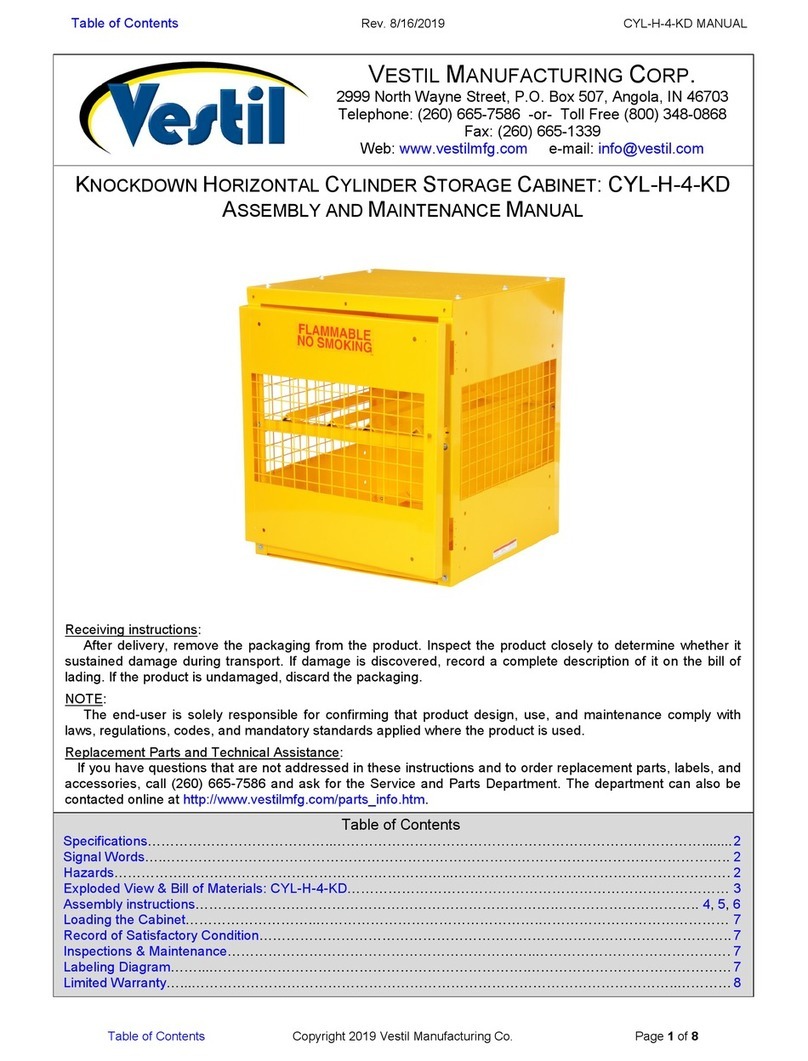
Vestil
Vestil CYL-H-4-KD Quick guide
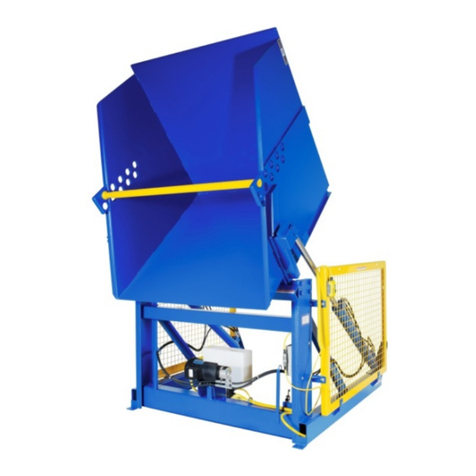
Vestil
Vestil HBD Series User manual

Vestil
Vestil FC-29 User manual
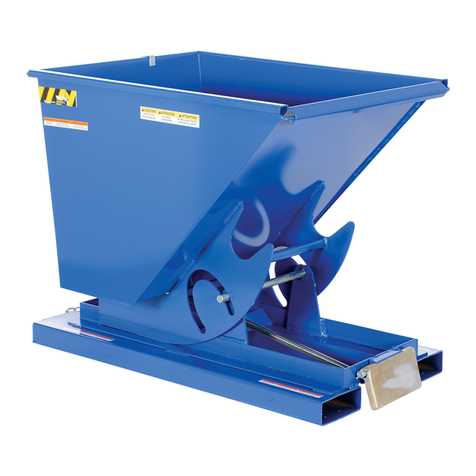
Vestil
Vestil D Series User manual
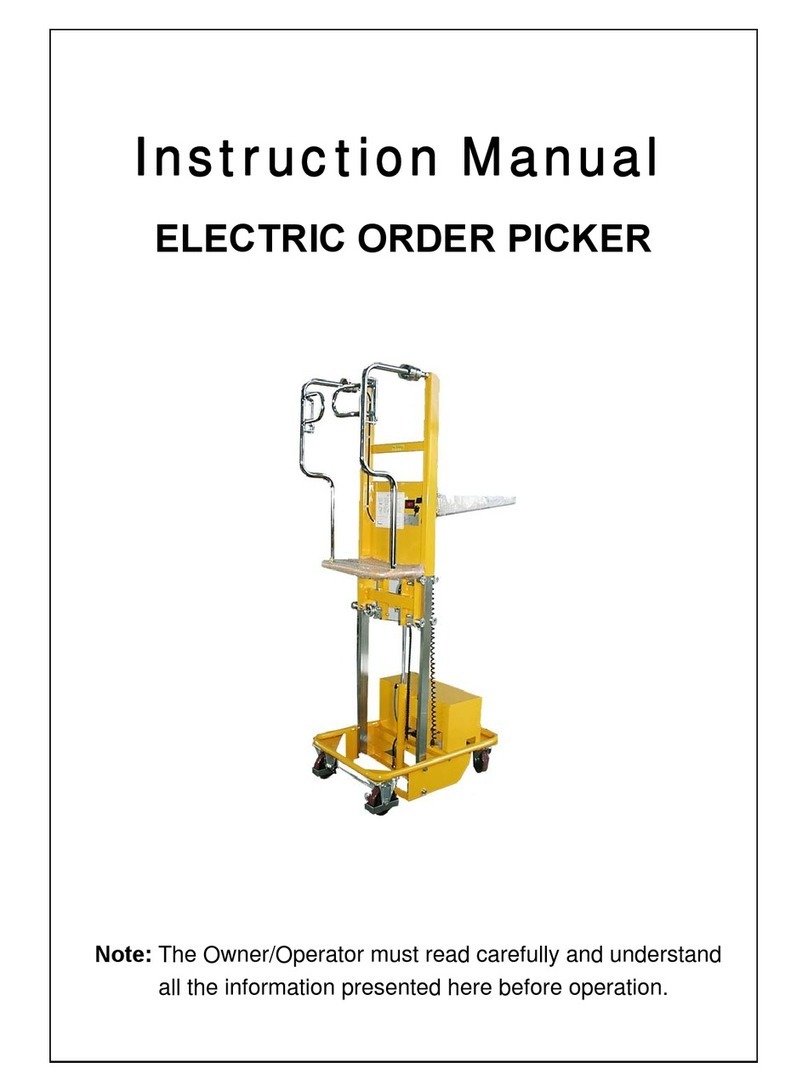
Vestil
Vestil EOP-440 User manual
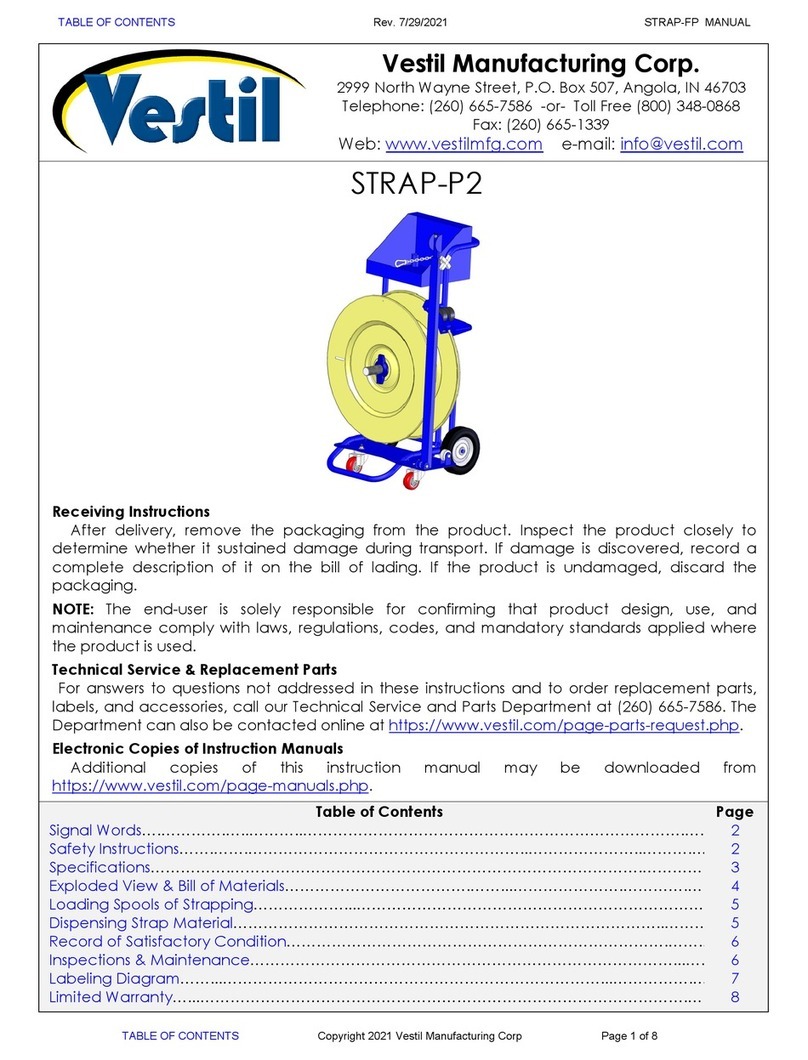
Vestil
Vestil STRAP-P2 User manual
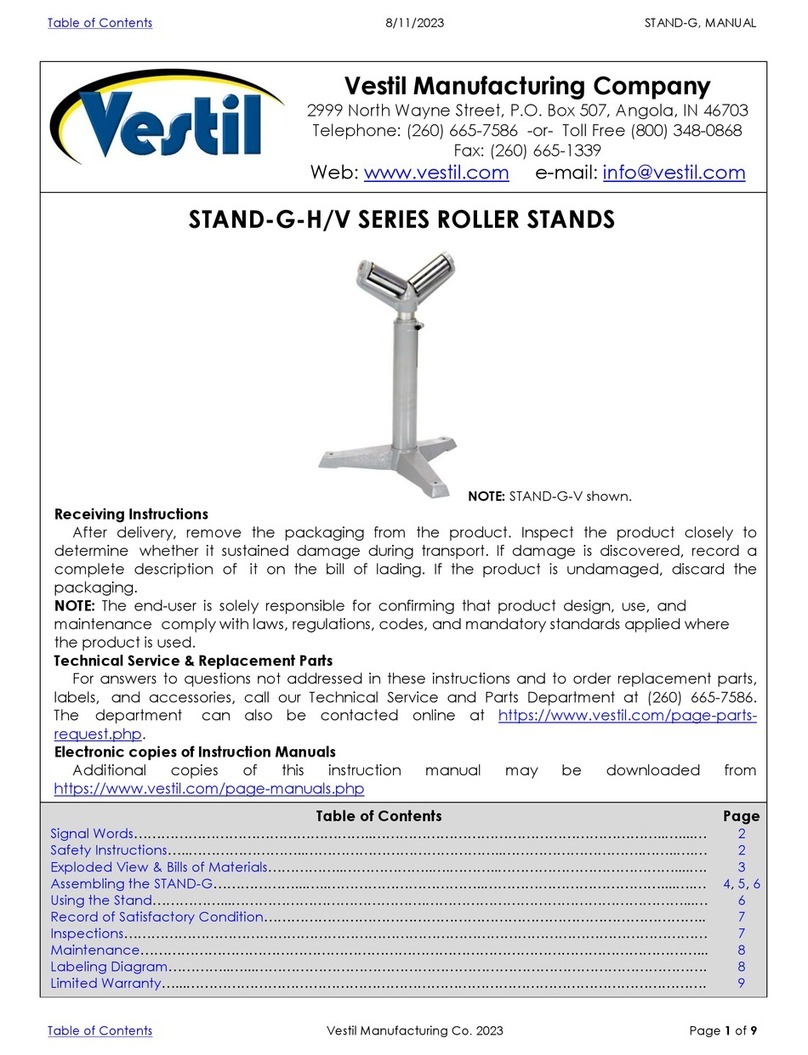
Vestil
Vestil STAND-G-H Series User manual
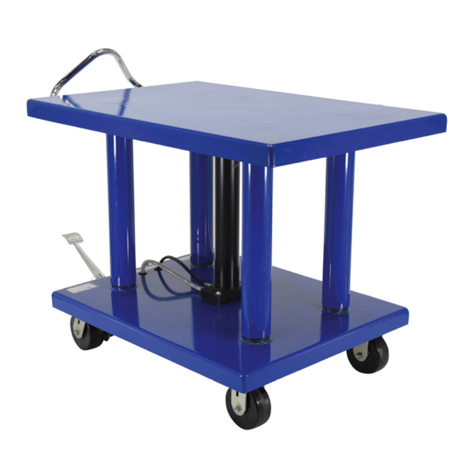
Vestil
Vestil HT-60-3248 User manual

Vestil
Vestil OCC-2 User manual

Vestil
Vestil H Series User manual

Vestil
Vestil PLC-P-FM User manual
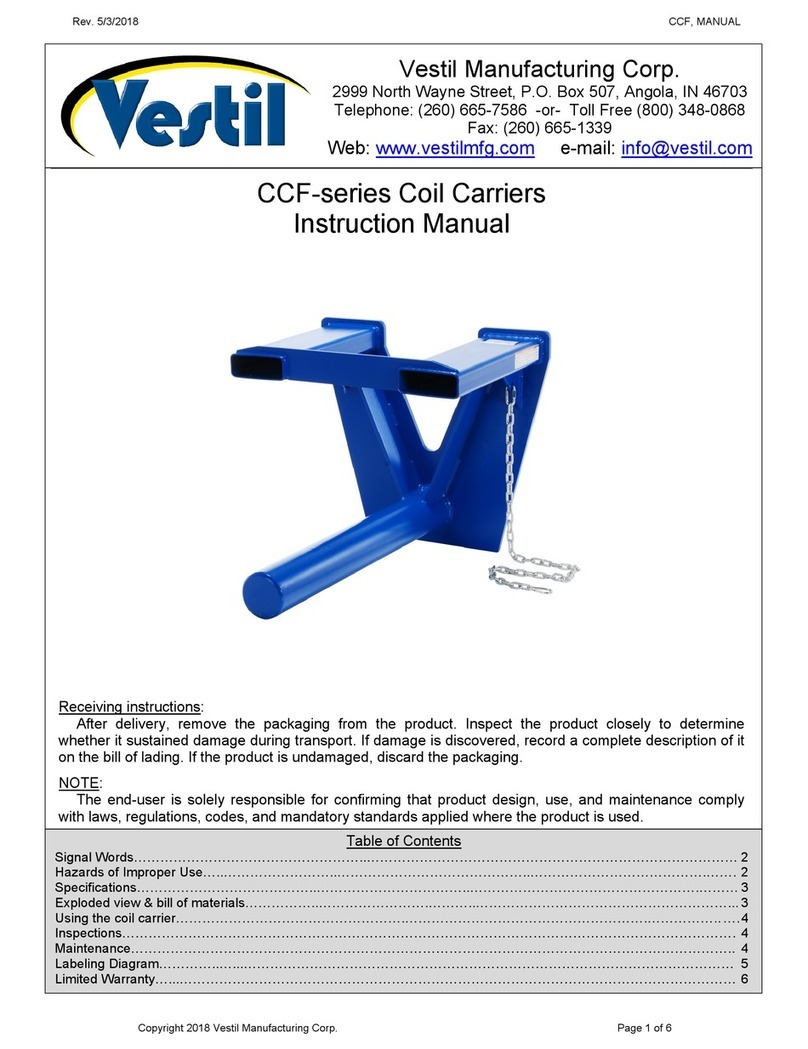
Vestil
Vestil CCF Series User manual
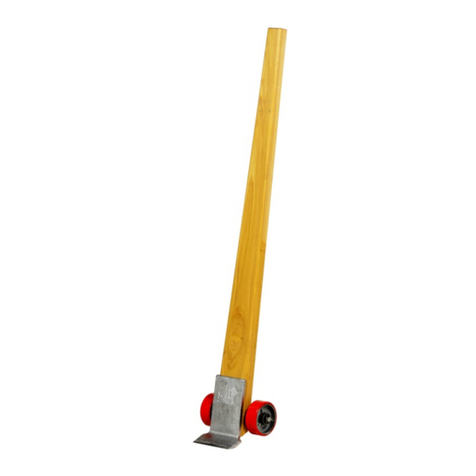
Vestil
Vestil PLB Series User manual
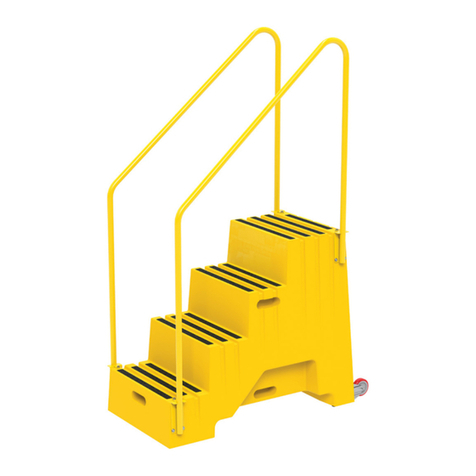
Vestil
Vestil VST-4-Y Operation instructions
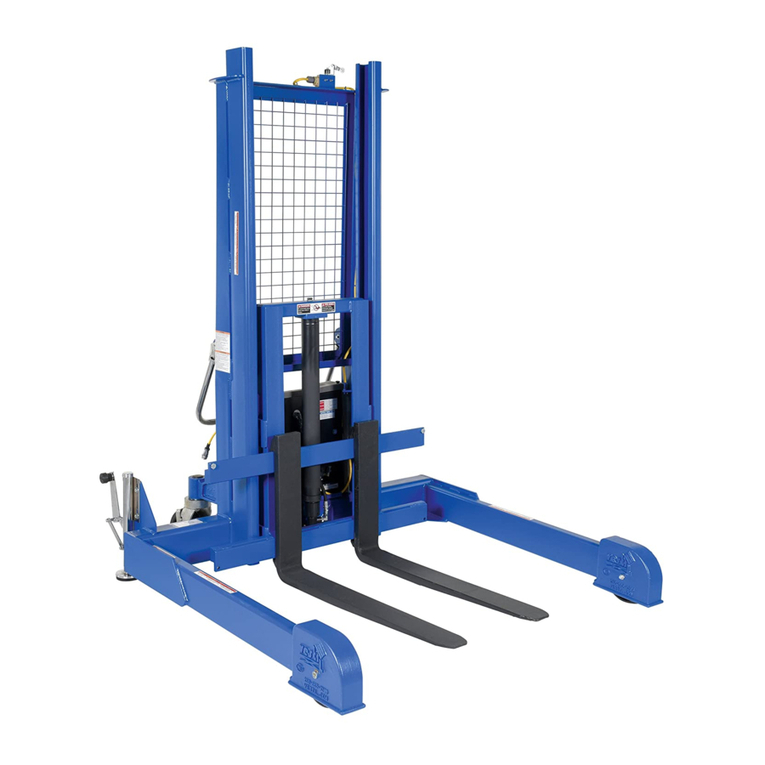
Vestil
Vestil PMPS Series User manual
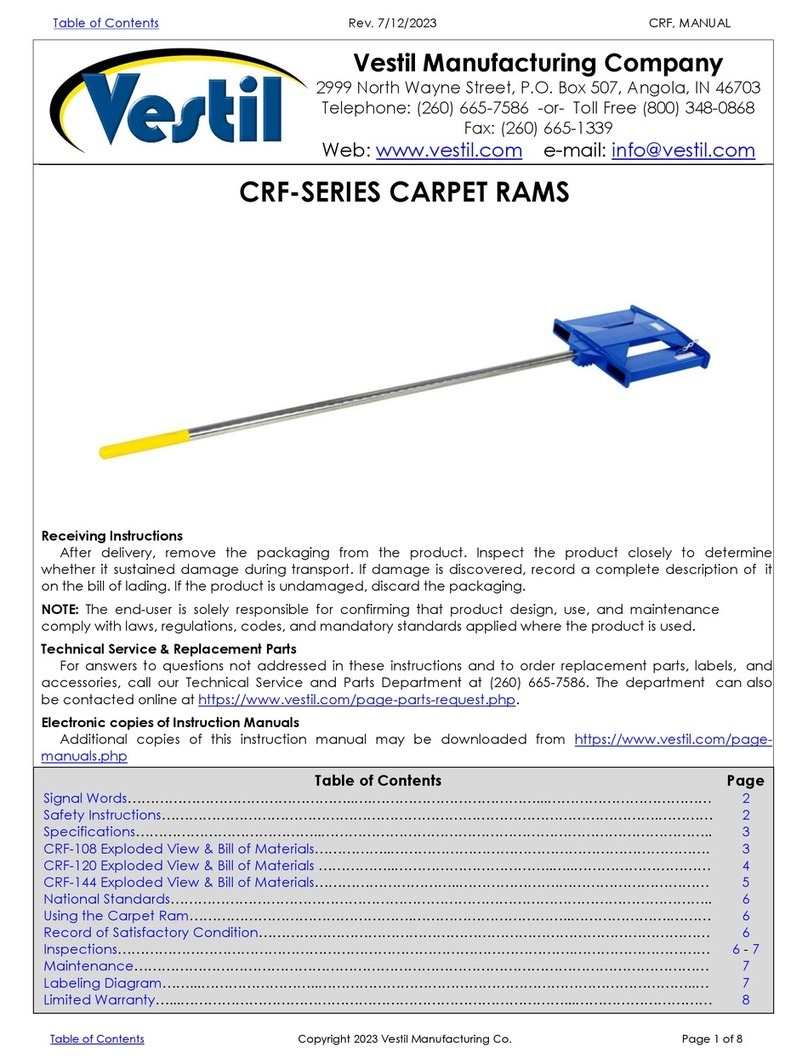
Vestil
Vestil CRF Series User manual
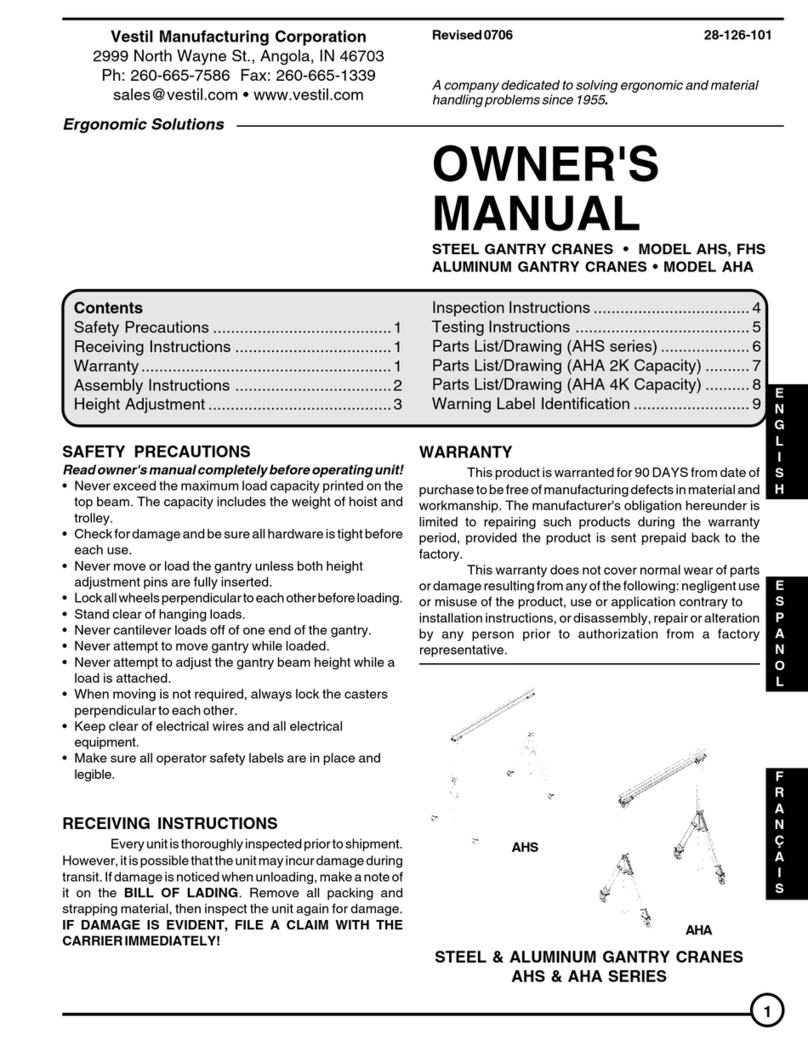
Vestil
Vestil AHS User manual

Vestil
Vestil BOL Series User manual



